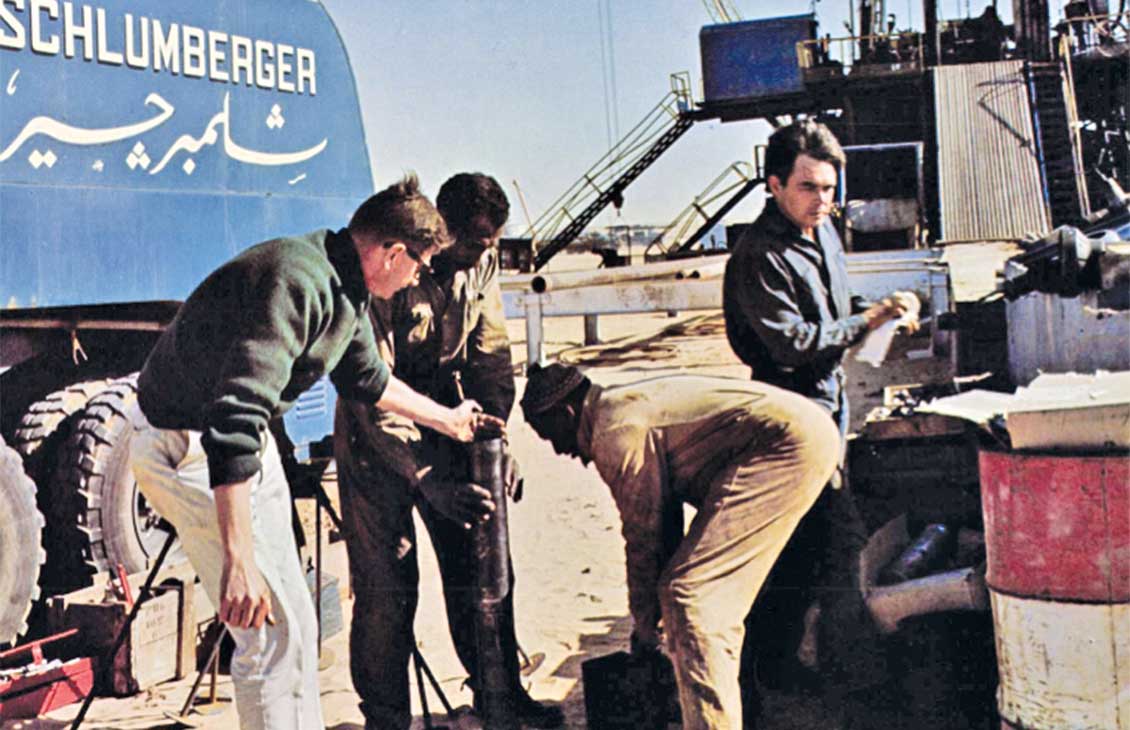1960s
SLB grows, from the ocean to the moon

By now, Schlumberger developments were finding valuable uses well beyond hydrocarbons and minerals activities. The company's growing expertise in deepsea drilling helped illuminate the ocean floor for scientific explorers. Its equipment was also useful in the search for sunken vessels—notably the submarine USS Thresher, which was lost off Cape Cod, Massachusetts, in 1963. Schlumberger provided an electrode able to detect spontaneous potential—the electricity generated by metal immersed in water—which indicated the location of the vessel on the seabed.
Schlumberger technology was also used in another realm entirely. The spacecraft that evolved throughout the "space race" decade of the 1960s, which culminated in the Apollo 11 moon landing in 1969, needed precisely the sort of remote sensing and accurate measuring equipment that Schlumberger was pioneering. The company provided high-reliability calculating machines to NASA in the early 1960s and still provides technologies for space exploration today.
Meanwhile, progress in the company's core businesses continued apace. Throughout the 1960s, Schlumberger engineers developed density logs to improve understanding of lithology and porosity, saturation measurements through casing, computer-processed dipmeter logs, digital tape processing in a logging truck, and sonic logging.
The company also grew steadily through acquisitions and partnerships. In 1960, it formed Dowell Schlumberger, a 50/50 joint venture with Dow Chemical, which specialized in pumping services for the oil industry. In 1961, Solartron, a UK electrical instrumentation company, was acquired, and in the same year, Société d'Instrumentation Schlumberger was founded to coordinate expansion into electronics and measurement systems. In 1962, the company acquired the cable operations of Vector Cable and Daystrom measurement instruments. In 1964, Schlumberger created the Neptune drilling company by merging parts of its Languedocienne operation with Forex, of which it owned 50% at the time.
The growing company also required improved access to funding, prompting the listing of Schlumberger Limited on the New York Stock Exchange in 1962. Significant personnel changes included the appointment of Jean Riboud as chief executive officer of Schlumberger Limited in 1965 and the retirement of Henri Doll in 1967, after an illustrious career. The Ridgefield research facility was renamed the Schlumberger–Doll Research Center in his honor.
Doll's research and expertise had helped ensure the company was well prepared to face a range of new challenges emerging by the end of the 1960s, as the wells to be logged got deeper than 20,000 feet and exploration moved into tricky environments, such as Alaska.
| Year | Event |
|---|---|
| Year 1960 | Event Forms Dowell Schlumberger (50% Schlumberger, 50% Dow Chemical), specializing in pumping services for the oil industry Begins work on the sidewall neutron porosity (SNP) tool with high-pressure helium-3 detectors using epithermal neutrons to measure formation porosity Creates prototype of TDT thermal decay time tool for measuring formation saturation through casing using neutron population decay Founds Sociéte d'Instrumentation Schlumberger to coordinate expansion into electronics and measurement systems |
| Year 1961 | Event Introduces formation density tool Acquires Solartron (UK) electrical instrumentation company Completes first digitized dipmeter logs by computer, marking first successful computer processing of logs from tape |
| Year 1962 | Event Acquires Vector Cable operations and Daystrom measurement instruments Schlumberger Limited listed on the New York Stock Exchange Commercializes the compensated density log, followed by the pad-type neutron log acquired by the SNP tool |
| Year 1964 | Event Creates Neptune drilling company (50% Forex, 50% Languedocienne) |
| Year 1965 | Event Processes digitized log tape in a truck Begins development of CNL compensated neutron logging tool, a two-detector neutron tool for through-casing porosity measurement Jean Riboud appointed CEO of Schlumberger Limited |
| Year 1966 | Event
Develops small minitron and constructed 1 11/16-in TDT tool for through-tubing production logging Achieves first Schlumberger–Doll Research patent in sonic logging First well log in Norway is performed |
| Year 1967 | Event
On Henri Doll's retirement, renames the Ridgefield facility to the Schlumberger–Doll Research Center in his honor Introduces Model TTR (truck tape recorder) to replace nine-galvanometer R9 recorder |
| Year 1968 | Event Sends a well log from the engineering center in France to the research center in the US, via commercial satellite, for the first time |
| Year 1969 | Event Incorporates experimental lithology into Litho-Density photoelectric density logging tool for direct measurement of formation lithology |
